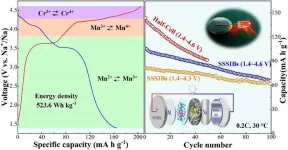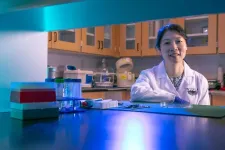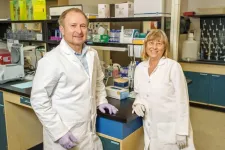(Press-News.org) The cosmos is a unique laboratory for testing the laws of physics, in particular those of Euler and Einstein. Euler described the movements of celestial objects, while Einstein described the way in which celestial objects distort the Universe. Since the discovery of dark matter and the acceleration of the Universe’s expansion, the validity of their equations has been put to the test: are they capable of explaining these mysterious phenomena? A team from the University of Geneva (UNIGE) has developed the first method to find out. It considers a never-before-used measure: time distortion. The results are published in Nature Astronomy.
The theories of Leonhard Euler (1707-1783) and Albert Einstein (1879-1955) revolutionised our understanding of the Universe. With the famous equation that bears his name, Euler gave scientists a powerful tool for calculating the movements of galaxies in the Universe. With his theory of general relativity, Einstein demonstrated that the Universe is not a static framework: it can be distorted by star clusters and galaxies.
Physicists have tested these equations in all sorts of ways, which have so far proved successful. However, two discoveries continue to put these models to the test: the acceleration of the Universe’s expansion and the existence of invisible dark matter, which is thought to account for 85% of all matter in the cosmos. Do these mysterious phenomena still obey the equations of Einstein and Euler? Researchers are still unable to answer this question.
The missing ingredient
"The problem is that current cosmological data do not allow us to differentiate between a theory that breaks Einstein’s equations and one that breaks Euler’s equation. This is what we demonstrate in our study. We also present a mathematical method for solving this problem. This is the culmination of ten years of research", explains Camille Bonvin, associate professor in the Department of Theoretical Physics in the UNIGE Faculty of Science and first author of the study.
Researchers were unable to differentiate between the validity of these two equations at the very edge of the Universe because they were missing an "ingredient": the measurement of time distortion. "Until then, we only knew how to measure the speed of celestial objects and the sum of the distortion of time and space. We have developed a method for accessing this additional measurement, and it’s a first", says Camille Bonvin.
If the time distortion is not equal to the sum of time and space - i.e. the result produced by the theory of general relativity - this means that Einstein’s model does not work. If the time distortion does not correspond to the speed of the galaxies calculated with the Euler equation, this means that the latter is not valid. "This will allow us to discover whether new forces or matter, which violate these two theories, exist in the Universe", explains Levon Pogosian, professor in the Department of Physics at Simon Fraser University, in Canada, and co-author of the study.
Reality check
These results will make a crucial contribution to several missions whose aim is to determine the origin of the accelerated expansion of the Universe and the nature of dark matter. These include the EUCLID space telescope, which will be launched in July 2023 by the European Space Agency (ESA), in collaboration with the UNIGE, and the Dark Energy Spectroscopic Instrument (DESI), which began its 5-year mission in 2021 in Arizona. There is also the international SKA (Square Kilometre Array) giant radio telescope project in South Africa and Australia, which will begin observations in 2028/29.
"Our method will be integrated into these different missions. This is already the case for DESI, whom we have become external collaborators thanks to this research", Camille Bonvin enthuses. The research team has successfully tested its model on synthetic catalogues of galaxies. The next stage will involve testing it using the first data supplied by DESI, as well as identifying the obstacles and minimising the systematic features that could hamper its application.
END
Einstein and Euler put to the test at the edge of the Universe
A UNIGE team has developed the first method for testing together Einstein’s and Euler’s theories for the accelerating expansion of the Universe and dark matter.
2023-06-22
ELSE PRESS RELEASES FROM THIS DATE:
Promoting high energy Na4MnCr(PO4)3 capable of three-electron reaction for SSSMBs
2023-06-22
They published their work on June. 9 in Energy Material Advances.
"The development of high safety and high energy density SIBs is imperative," said paper author Zhongyue Wang, lecture with the College of electronic and optical engineering & college of flexible electronics (future technology), Nanjing University of Posts and Telecommunications. "Currently, great progress has been made in sodium-ion batteries, but their energy density is still much lower than LIBs limited by the cathode."
Wang explained that NASICON-type phosphate (NaxMM’(PO4)3, M, M' =transition metal Ti, V, Cr, Mn, Fe, Co and Ni) is regarded ...
Statewide study explores how pre-existing disease has influenced the COVID-19 experience
2023-06-22
INDIANAPOLIS - A study of more than three-quarters of a million Indiana COVID-19 cases is one of the first to focus on the disease in the Midwest. The research examines the relationship between the presence of pre-existing disease and COVID-19 outcomes in a region that has some of the highest prevalence of comorbidities, including hypertension, chronic obstructive pulmonary disease (COPD) and diabetes.
The study, conducted by researchers from Regenstrief Institute, Indiana University and The Ohio State University sourced data through the COVID-19 Research Data Commons. For COVID-19 patients, research demonstrated the pre-existing ...
AI could transform the way we understand emotion
2023-06-22
An emotion recognition tool - developed by University of the West of Scotland (UWS) academics - could help people with neurodiverse conditions including autism.
Traditionally, emotion recognition has been a challenging and complex area of study. However, with recent advancements in vision processing, and low-cost devices, such as wearable electroencephalogram (EEG) and electrocardiogram (ECG) sensors, UWS academics have collaborated to harness the power of these technologies to create artificial intelligence (AI) which can accurately read emotion-related signals from brain and facial analysis.
Professor Naeem Ramzan, ...
More positive outcomes when elderly are treated locally
2023-06-22
Older people with health problems often need some form of intermediate level monitoring, care and treatment services.
They may not need the resources of a hospital but do require somewhat more advanced help than a nursing home can usually offer. "Intermediate care units" are primarily intended to replace an acute hospital admission, but are occasionally also used following admission.
“Intermediate care units are the newest trend in health policy, and Norway is way ahead of the curve in this regard,” says Pål Erling Martinussen, a professor in the Department of Sociology and Political ...
The ACMG Releases 2023 Update to Secondary Findings Gene List; SF v3.2
2023-06-22
The American College of Medical Genetics and Genomics (ACMG) has released its highly anticipated 2023 update to the recommended minimum gene list for the reporting of secondary findings (SF): “ACMG SF v3.2 List for Reporting of Secondary Findings in Clinical Exome and Genome Sequencing: A Policy Statement of the American College of Medical Genetics and Genomics (ACMG).” In 2021, the ACMG Board of Directors and Secondary Findings Working Group (SFWG) stated that the College would update the list annually. Today’s update (SF v3.2) is being published in ACMG’s flagship journal, Genetics ...
Lupus Research Alliance honors Carola Vinuesa, MD, PhD, for discovering a specific gene variant that causes lupus in some patients
2023-06-22
NEW YORK, NY – June 22, 2023 – The Lupus Research Alliance awarded its 2023 Lupus Insight Prize to Carola Vinuesa, MD, PhD, of The Francis Crick Institute, for her seminal discovery that a mutation in a specific human gene causes systemic lupus erythematosus (SLE), uncovering an important target for the development of novel treatment. The Lupus Insight Prize is awarded each year to an outstanding investigator who has made a significant discovery that will advance our understanding of the pathogenesis, diagnosis, or treatment of lupus.
Dr. Vinuesa ...
Portable tool to diagnose and monitor sickle cell disease receives U.S. patent
2023-06-22
In the United States, sickle cell disease affects about 100,000 people and about 2 million Americans carry this genetic mutation. The most common and serious problems caused by sickle cell disease are anemia, pain and organ failure – stroke affects about 10 out of 100 children who have this disease. The national median life expectancy for people who have sickle cell disease can reach up to age 50.
This inherited, lifelong blood disorder is characterized by rigid and sickle-shaped red blood cells due to a dramatic change in their morphology. They stick to blood vessels, blocking ...
Model blood-brain barrier could improve newborn meningitis treatment
2023-06-22
Washington, D.C. – Investigators in Israel and Italy have developed a model of the blood-brain barrier, studies of which may lead to prevention of meningitis in newborns. The research is published in Microbiology Spectrum, a journal of the American Society for Microbiology.
The investigators further developed a platform called organs-on-a-chip—invented during the 2000s—to construct the model. These devices, which are modeled after microchips, contain tiny channels lined with living human ...
TTUHSC-TTU research collaboration leads to possible drug targets for Leishmaniasis
2023-06-22
Leishmaniasis is a tropical disease caused by parasites known as Leishmania, which are transmitted to humans and animals through the bites of more than 90 species of sand flies. Considered a neglected tropical disease, leishmaniasis is found in approximately 88 countries primarily located in South and Central America, the Middle East and western Asia. As many as 1 million new cases are diagnosed each year and more than 350 million people are at risk of infection. Some forms of the disease ...
'Poo transplant' trial provides hope for liver disease patients
2023-06-22
The UK is to launch a clinical trial of a ‘poo transplant’ that researchers believe could treat advanced liver disease and fight antimicrobial resistance.
The trial’s investigators also provide evidence for the first time that a faecal transplant can dramatically improve gut health.
The PROMISE trial is led by King’s College London and funded by a National Institute for Health and Care Research (NIHR) and Medical Research Council (MRC) partnership. It will recruit patients with cirrhosis from across the UK to test whether oral Faecal Microbiota Transplant (FMT) capsules from freeze-dried stool from healthy volunteers reduces the likelihood of getting an ...
LAST 30 PRESS RELEASES:
Signature patterns of brain activity may help predict recovery from traumatic brain injury
Dresden study uncovers new key mechanism in cancer cells
New species are now being discovered faster than ever before, study suggests
Cannabis-based products show limited short-term benefit for chronic pain, with increased risk of adverse effects
Cannabis products with more THC slightly reduce pain but cause more side effects
Clearing the brain of aging cells could aid epilepsy and reduce seizures
Brain injuries linked with potential risk of suicide, new study finds
New technique lights up where drugs go in the body, cell by cell
New study finds movement of fishing fleets can reveal shifts in marine ecosystems
Embargoed: New evidence points to potential treatment for vascular dementia
Study uncovers disrupted brain balance in alcohol dependence
Working in groups can help Republicans and Democrats agree on controversial content moderation online
Structural findings reveal how distinct GPCR ligands create different levels of activation
Anything-goes “anyons” may be at the root of surprising quantum experiments
UC review: Maximizing workplace opportunity for veterans
From generation to complex control: Metasurfaces make perfect vortex beams "within reach"
Thin-film lithium niobate-based detector: recent advances and perspectives
Exploring why some people may tend to persistently make bad choices
How cells balance their protein levels
Nirsevimab vs RSVpreF vaccine for RSV–related hospitalization in newborns
Effectiveness and impact of maternal RSV immunization and nirsevimab on medically attended RSV in US children
AI gives scientists a boost, but at the cost of too many mediocre papers
Next-generation vision model maps tree growth at sub-meter precision
Genes aren’t destiny for inherited blindness, study shows
MIT study: High-fat diets make liver cells more likely to become cancerous
Exposure to multiple fine particulate matter components and incident depression in the US Medicare population
Risk of burdensome health care spending over time in the US
Nirsevimab against hospitalizations and emergency department visits for lower respiratory tract infection in infants
New microfluidics technology enables highly uniform DNA condensate formation
A new strategy for immune tolerance
[Press-News.org] Einstein and Euler put to the test at the edge of the UniverseA UNIGE team has developed the first method for testing together Einstein’s and Euler’s theories for the accelerating expansion of the Universe and dark matter.



